Celebrating Four Swords Anniversary Edition’s “Realm of Memories” Mode
Posted on March 18 2024 by Rod Lloyd

The Legend of Zelda fans were feasting in 2011.
With the series celebrating its 25th anniversary that year, Nintendo pulled out all the stops to make sure every corner of the fanbase was well fed on Zelda goodness. Ocarina of Time 3D — a remake long desired by fans — released that June, Skyward Sword — the first home console Zelda game in five years — released that November, Hyrule Historia — and the official Zelda timeline with it — was published in Japan that December, and special anniversary symphony concerts were held in Tokyo, Los Angeles, and London throughout the year — making way for the successful Symphony of the Goddesses series, which debuted the following year.
Amongst all the excitement, however, one 2011 Zelda release tragically went under the radar.
The Legend of Zelda: Four Swords Anniversary Edition released on Nintendo’s DSiWare service on September 28th, 2011. More than just a standalone port of 2002’s Four Swords (initially packaged with the Game Boy Advance version of A Link to the Past), this title added a much-needed single-player mode, more difficulty options, and new challenges to tackle.
Anniversary Edition was only available to download until February 2012, and then again temporarily in 2014. Tragically, therefore, fans who missed out on the remake during these obscenely brief windows of availability never got to experience my favorite feature from Anniversary Edition: the “Realm of Memories” mode.
The Realm of Memories, unlocked after players complete Vaati’s Palace for the first time, is a collection of three new stages that bring the Four Swords formula to classic locations from The Legend of Zelda, A Link to the Past, and Link’s Awakening. These stages set aside the generalized look and sound of Four Swords‘ standard stages, and instead take on the musical pallets and visual presentations of the inspiring games. Chiptune music and 8-bit visuals accompany the Legend of Zelda and Link’s Awakening levels, while Super Nintendo sights and sounds accompany the Link to the Past levels. It’s all very charming.
The Realm of Memories has always been the thing that has stuck with me the most after playing Four Swords Anniversary Edition, and I’m sad that many players missed out on the chance to experience it. So, as we celebrate all things Four Swords this week, allow me to break down Anniversary Edition‘s Realm of Memories and explain what exactly makes this mode so special.
A Celebration of Zelda‘s Legacy
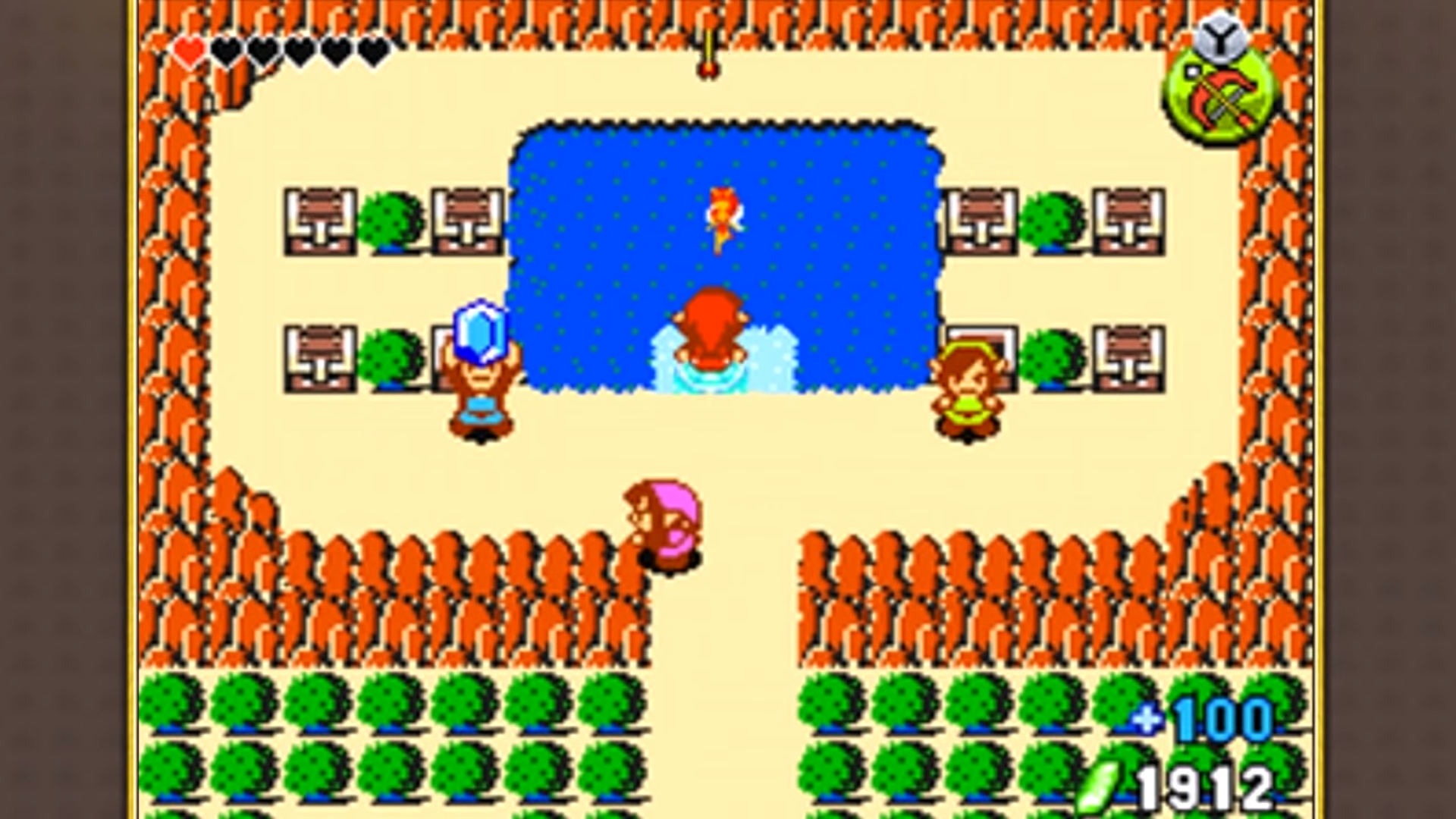
In many ways, Four Swords Anniversary Edition was the perfect release for Zelda‘s 25th anniversary. The GBA original, beyond introducing multiplayer to the Zelda series, borrowed elements from or paid homage to just about every Zelda title to come before it. Character designs, sound effects/samples, puzzle mechanics, and dungeon items, to name a handful of examples, were lifted from The Legend of Zelda, A Link to the Past, Ocarina of Time, Majora’s Mask, and everything in between. The game even adopted its general art style from The Wind Waker (which released a few weeks after Four Swords), and its Gnat Hat item clearly forecasted the central gimmick of The Minish Cap.
Four Swords can therefore be seen as the Zelda series’ first “celebration title,” releasing years before Hyrule Warriors made “celebration title” a marketing phrase.
The Realm of Memories mode in Anniversary Edition takes this celebration theme to the next level. The numerous callbacks from the base game are still in place here — from the enemies, to the items, to the puzzles — but they now occupy familiar spaces from The Legend of Zelda‘s storied history too. More than a parade of one-off nods within a largely original adventure, everything seen and heard in this realm is a callback. Everything is a celebration here.
Four Swords‘ main campaign may feature plenty of opportunities to use classic Zelda items like Pegasus Shoes and Roc’s Cape, but I would argue that these items lack a degree of context there. They don’t feel like a part of the world beyond being contrived tools for a series of constructed obstacles. In the Realm of Memories, however, the items of Four Swords feel much more native to the worlds they inhabit. The fact that these levels are already based on existing environments — fragments of fleshed-out worlds we’ve explored before — certainly helps in this regard, but things go even further when you consider what items the developers chose for which environments.

Let’s use Four Swords‘ Chain Chomp item as an example. In the base game, the Chain Chomp is simply a silly reference to the Mario series, Link’s Awakening, and, to a lesser extent, A Link to the Past… but that’s all it is. In the context of the game itself, with its indistinct puzzle rooms and combat gauntlets, the Chain Chomp is just a reference, a gimmicky tool from another game and another game series that is largely out of place in the world of Four Swords.
But consider the Chain Chomp in the Realm of Memories. In this mode, the Chain Chomp is only available to use in a level based on Goponga Swamp from Link’s Awakening. Those who have played that Game Boy classic will know that Goponga Swamp is the area that requires BowWow, the Chain Chomp companion, to traverse. Due to this association, the Chain Chomp item feels much more indigenous to this level than to any other level in Four Swords. The item’s placement was a deliberate choice by the developers, for the purpose of giving both the item and the level in which it’s placed the most nostalgic resonance possible. The same level of care was done for several of Four Swords‘ items throughout the Realm of Memories.
Returning to the idea of celebration, the deliberate item placement in the Realm of Memories also offers unique “mash-up” opportunities within its established Zelda environments.
For example, the placement of the Gnat Hat (which shrinks Link down a la The Minish Cap) in A Link to the Past‘s Skull Woods effectively makes a transformative whole of two distinct Zelda experiences. The Realm of Memories uses the Gnat Hat to mash up A Link to the Past and The Minish Cap, offering players a fresh way to look at the world of the former with a mechanic central to the latter. Likewise, making Roc’s Cape available in the Legend of Zelda stage brings the movement options of contemporary Zelda titles to the world of the first one. Seeing a nimble version of Link jump over pits and swim through water in an 8-bit Hyrule really demonstrates the progress Link and the player have made over the course of the series’ history.
More than anything, the Realm of Memories can be seen as a guided tour of Zelda‘s early history, with Four Swords‘ multiplayer gameplay simply serving as the glue that holds it all together. You and your friends can journey from Link’s Awakening‘s Tal Tal Heights (in all its monochrome glory), to A Link to the Past‘s Hyrule Castle, to The Legend of Zelda‘s Lost Woods, with the audio-visual presentation of each level changing to match its source material. Even the enemies consistent with the other modes of Four Swords are altered visually to match a level’s aesthetic. The entire experience is a nostalgic walk down memory lane for Zelda veterans, and it’s an inviting introduction to these worlds for Zelda newbies.
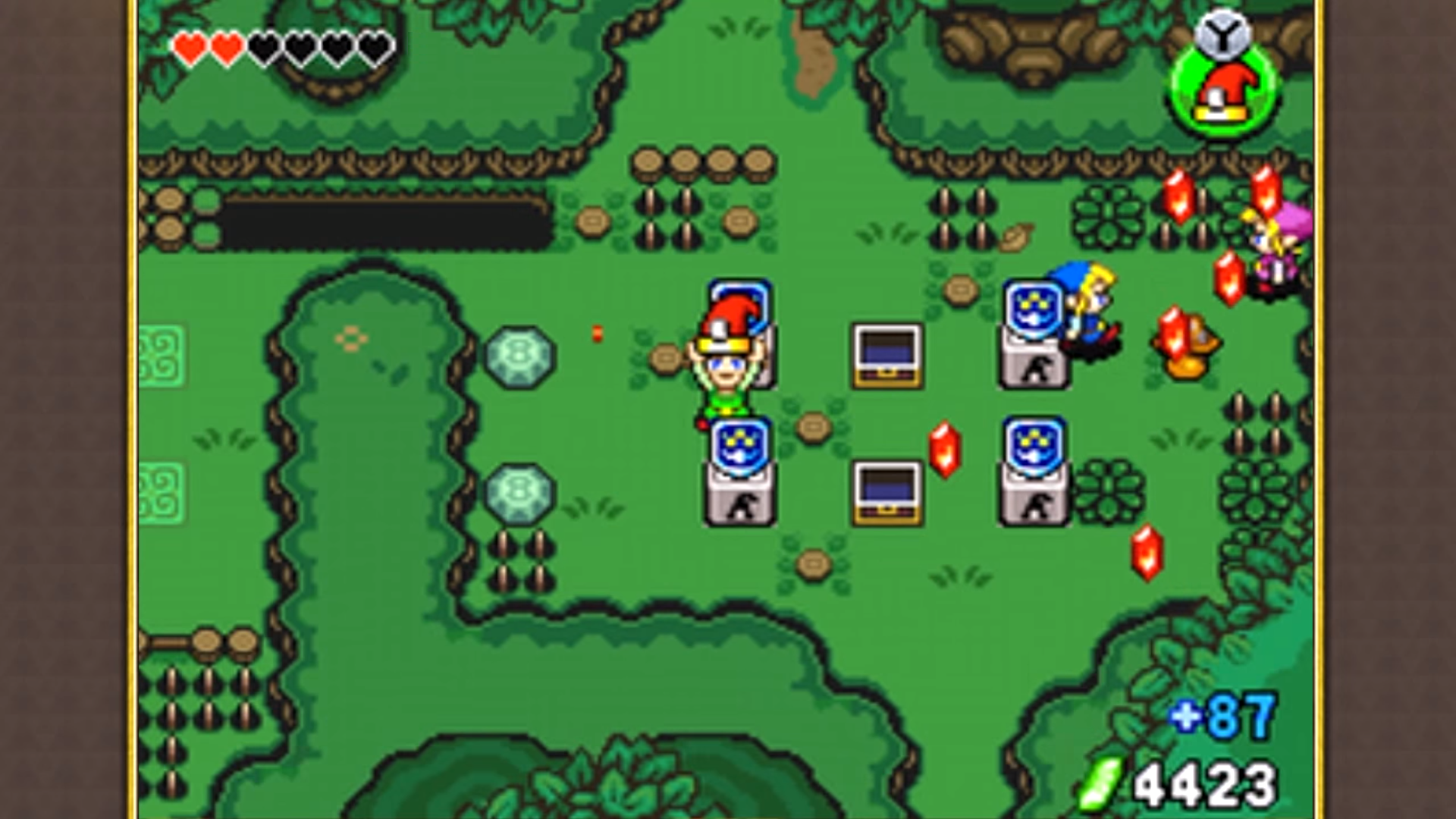
Unlike the stages of Four Swords‘ main adventure, the Realm of Memories stages are not randomized and instead feature a set progression of the levels each. The Link’s Awakening stage, for example, features levels based on the Mysterious Forest/Goponga Swamp, Tail Cave, and Tal Tal Heights, respectively. I see the value in this approach, as players are guaranteed to see every environment and overcome every challenge thought up by the developers over the course of their playthrough. As someone who doesn’t quite vibe with the roguelike genre, I find this mode to be Four Swords‘ most satisfying to complete for this very reason.
And these levels aren’t simple rehashes either. We’ve already talked item placement and gameplay mash-ups, but, in making the most of Four Swords‘ unique multiplayer mechanics, the Realm of Memories provides plenty of new experiences in these old environments. Puzzles and challenges, while aesthetically consistent with a level’s inspired game, are built around Four Swords‘ multiplayer gameplay. Players may need to throw each other or use the Magnetic Glove items to cross gaps in dungeons. Hazards unique to Four Swords, like pesky spring tiles, are now scattered around overworld areas. And, as a way to promote friendly competition amongst teams, Rupee hordes are now hidden all around these familiar maps, such as in Link’s Awakening‘s Telephone Booths or The Legend of Zelda‘s caves.
Call me an old soul desperate for days gone by, but I love when new entries in a franchise return to locations from older entries. Seeing Ocarina of Time‘s Temple of Time in Twilight Princess, Super Mario 64‘s castle courtyard in Super Mario Odyssey, and Dark Souls‘ Anor Londo in Dark Souls III were all extremely rewarding experiences for me. It’s like returning to your hometown after spending some time away. In those moments, we can reflect on what has changed, and we can celebrate what hasn’t.
For all the legacy the Legend of Zelda series has built up over the years, the games can afford to revisit some familiar ground once in a while. That’s what Four Swords so effectively does with the Realm of Memories.
A Satisfying Gauntlet

Beyond serving as a celebratory tribute to Zelda‘s past achievements, the Realm of Memories provides a fun and satisfying gameplay experience in its own right.
In many ways, each level in the Realm of Memories, despite its aesthetic inspiration, is a dungeon in and of itself. Of course Link’s Awakening‘s Tail Cave, A Link to the Past‘s Hyrule Castle, and The Legend of Zelda‘s Eagle function as dungeons — just as they did in their original games — but I would argue that even the levels inspired by overworld areas like Goponga Swamp, the Lost Woods, and Central Hyrule essentially function as dungeons as well.
Like a traditional Zelda dungeon, each level is broken up into distinct segments that are separated by locked doors, bomb-able walls, and other such obstacles. These segments may not be “rooms” in the traditional sense, but, stripped of their visuals, they function exactly like rooms in any given Zelda dungeon. Segments are separate by a combination of contextual barriers native to the level — like castle walls in A Link to the Past or 8-bit trees in The Legend of Zelda — and immovable blocks that function like locked doors in dungeons, giving each level its labyrinthine feel. And players, as they do in dungeons, need to fight monsters, solve puzzles, and collect items and keys to proceed from segment to segment in order to reach the end of the level.
For lack of a better descriptor, these levels are basically “dungeons without dungeons.”
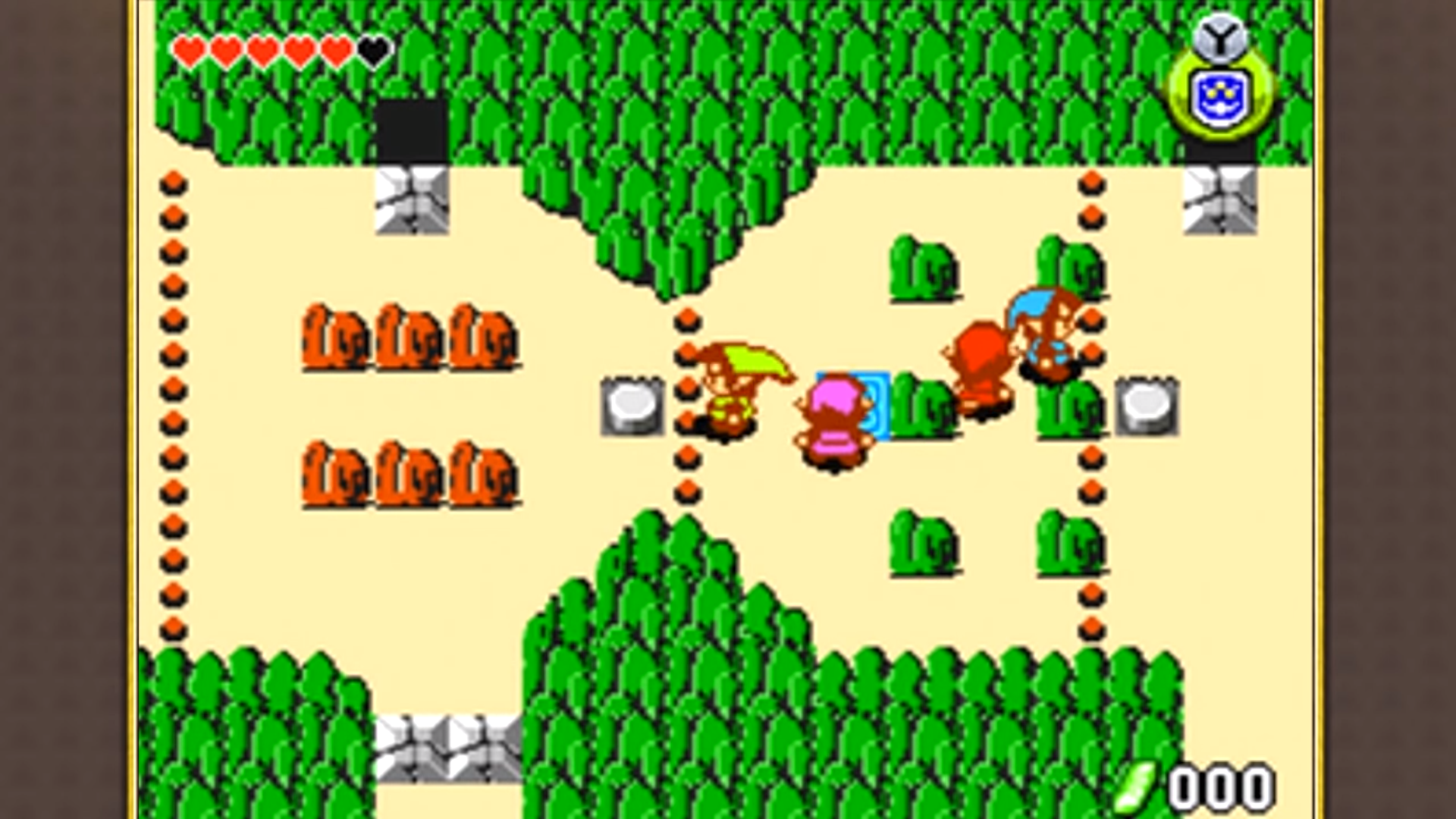
There’s no better example of the Realm of Memories’ “dungeons without dungeons” than the first level of the Legend of Zelda stage, based on the Central Hyrule overworld areas from the very first Zelda game. What was once a rather open, explorable piece of real estate in the original game has been reconstructed into a dungeon-like set of combat encounters and puzzle rooms.
The level begins as 1986’s The Legend of Zelda does, with Link (or Links) standing in front of a cave in the Hyrule overworld. But, upon inspection, the cave doesn’t lead to a separate screen as it did in the original game; it now serves as a secret path to a fenced-in area to the north, flanked on both sides by two switches. This northern area (the one infested with Octoroks in the original game), with its barriers and switches, now functions like any given room in a traditional Zelda dungeon. There’s an obvious puzzle to solve: two Links need to stand on the switches at the same time to reveal a secret in the central fenced-in area.
But things aren’t that easy. The left switch is inaccessible because the northwestern path from the starting area is blocked by a pair of bomb-able blocks; we need bombs! Luckily, another cave to the west reveals a hidden path to another area — another room — with some bombs to pick up. Players can then use these bombs to proceed further into the level — the dungeon — and finally step on that second switch. They can even use the newly acquired bombs to loot the area for Rupees!
The time has come, then. Two players can activate both switches, presumably to reveal an item or key in the central area. But, as you’d see in a dungeon, activating the switches reveals a trap instead; two Moblins spawn in the central area, no doubt startling any players standing there expecting a prize. Players now have to fight their way out of the predicament, whether with their swords or with the bombs they acquired. And with the Moblins dispensed, players can finally claim a key, use it on a key block to the east, and proceed further into the level.
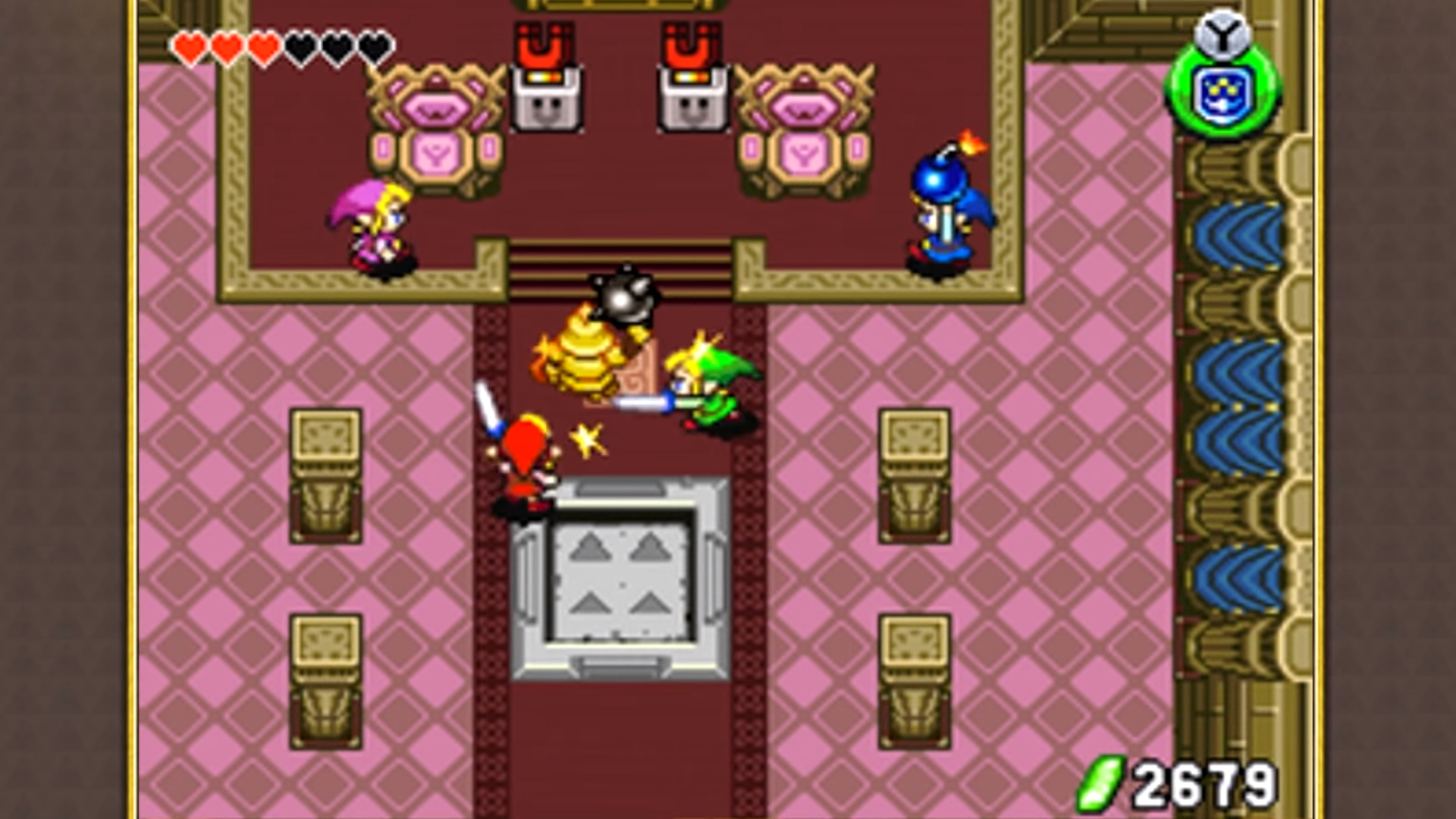
Despite its resemblance to The Legend of Zelda‘s wide, open overworld, this level — thanks to its challenges, pacing, and progression — much more closely resembles the dungeons of early Zelda games in practice. Just from the first few areas, with the locked doors, puzzles and traps, and allocation of items, players will clearly see the “dungeon without a dungeon” I’ve been describing. The concept carries forward to the remainder of the level, as players fight and puzzle-solve their way through Eastern Hyrule and navigate the perils of the northern lake. And there are even miniboss-like encounters with Armos and Eyegores.
Like the best and most remembered dungeons of Zelda‘s 2D heyday, the Realm of Memories’ levels offer a great variety of combat, puzzles, and treasure hunting. The same enjoyment that comes with testing yourself in a traditional Zelda labyrinth can be found here, as players methodically work their way through every challenge these areas put forth. And, thanks to Four Swords‘ arcade-like gameplay, these levels can afford to be more challenging than your standard Zelda experience. Believe me when I say that I died often trying to tackle these stages solo, making my successes all the sweeter.
The Realm of Memories is definitely a treat to the hardcore Zelda players out there. If you’re a fan of Hero Modes and combat gauntlets, you’re missing out if you own Four Swords Anniversary Edition and haven’t had a crack at this mode. And even if you’ve gone through it all before, there are still opportunities to challenge yourself with time trials, Rupee scores, and no-death runs.
A “Zelda Maker” Blueprint

Ever since the release of Super Mario Maker in 2015, fans have clamored for something similar for the Zelda series. Nintendo did offer up a watered-down version of the “Zelda Maker” concept with Link’s Awakening‘s Custom Dungeons in 2019, but it unfortunately did not live up to the complexity and versatility of Mario Maker and its sequel. A game that allows players to fully construct and customize their own Zelda dungeons, and perhaps even more, has therefore remained high on the wishlist for many fans.
If Nintendo ever pulled the trigger on an official Zelda Maker project, I’d argue that Four Swords Anniversary Edition‘s Realm of Memories provides the best blueprint for a successful execution. As discussed above, the realm already features many of the dungeon essentials one would expect from classic 2D Zelda games (switches, enemies, loot, traps, etc.); and, like with Super Mario Maker, its levels are based on the respective visual styles of multiple classic Zelda titles.
In many ways, the Realm of Memories is an official Zelda ROM hack. Pulling from the extensive Four Swords toolkit, the developers here were able to construct unique dungeon-like experiences in a variety of locations. They built their own puzzles, crafted their own enemy encounters, and ultimately achieved several satisfying quests for teams to tackle, all by remixing elements already available in Four Swords.
Imagine if you could do the same.
Imagine if you were given access to a version of the Four Swords toolkit, with its many dungeon items, its collection of monsters, and its set of puzzle objects. Imagine you could position and configure those elements in any way you wanted, whether in a dungeon or an overworld environment, in order to craft your own Zelda experiences. And imagine you could do all that in the visual style of your favorite 2D Zelda game. That sounds like a dream-come-true to me.
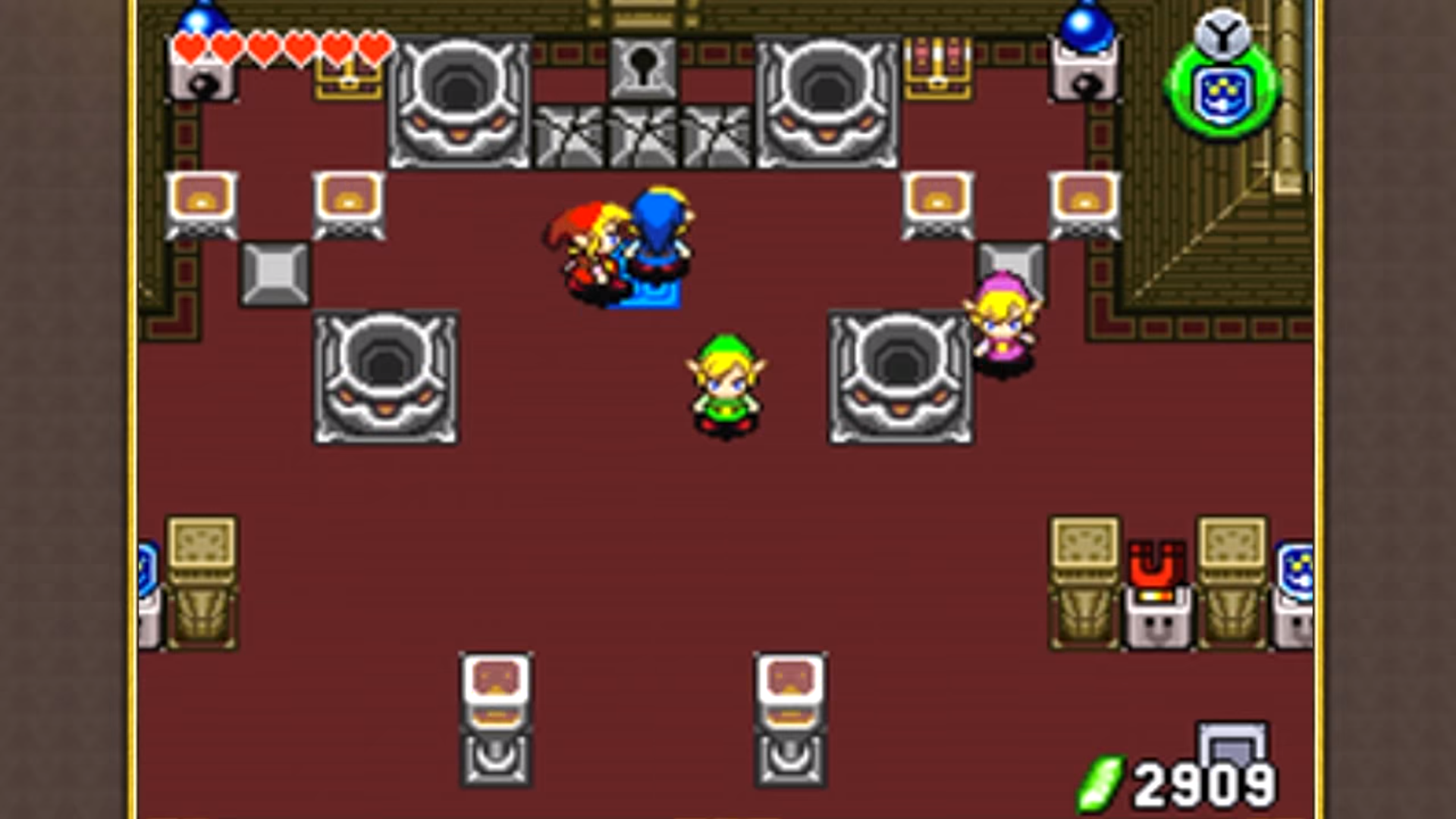
It’s also worth noting that the Realm of Memories’ levels are very dynamic, with areas and rooms that change as players perform certain tasks. For example, if a Link enters a particular part of a map, blocks may appear to obstruct the exits and mobs of enemies will spawn in looking for a fight. In another circumstance, if a player completely clears a room of enemies, a bounty of Rupees will appears as a reward.
Beyond the physical items that players are able to interact with, I can see the invisible level triggers and spawns from the Realm of Memories working well in a Zelda Maker environment. Level creators could place their own triggers and program their own item/enemy spawns, resulting in dynamic, perhaps even cinematic, gameplay moments and set pieces. Heck, music and sound effects could be made available in conjunction with these triggers, allowing creators to set the exact mood they’d want within their dungeons.
I can only think of a few additions that would need to be made to the Realm of Memories toolkit for it to be considered a fully functional Zelda Maker game. Other than the aforementioned music/sound customization, boss battles would need to be added to the experience. The Realm of Memories does have a varied bestiary as it stands now, but no monster is big and intimidating enough to stand in for bosses like Moldorm, Agahnim, and Ganon. So, by making the bosses of The Legend of Zelda, A Link to the Past, and Link’s Awakening part of existing Four Swords palette, players would be fully equipped for building their own Zelda dungeons.

Seeing as Four Swords is already a silly celebration of Zelda‘s decades-spanning history, the Realm of Memories’ transition to full-fledged Zelda Maker could come with some fan service as well. Just as Super Mario Maker made room for crossovers with its Mystery Mushroom item — as players could control sprites based on non-Mario characters like Link and Samus — this proposed Zelda Maker project could just as easily let players run around their custom dungeons as Mario, Tom Nook, Captain Falcon, or any other Nintendo character. Four Swords already features four different Links; what’s the harm in throwing some more characters into the mix?
Seeing the creative experiences that the developers of Four Swords Anniversary Edition crafted within the Realm of Memories, I can’t help but imagine what I’d create with the same collection of development tools at my fingertips. I could construct my own dungeon in The Legend of Zelda, or my own forest maze in A Link to the Past, or my own trading quest in Link’s Awakening. And I’m not even taking into account the extra features that could be added to that toolkit.
The Zelda fanbase has long been aware of the limitless potential a fully formed Zelda Maker would hold, but I don’t think we’ve realized that Four Swords‘ Realm of Memories demonstrated that potential so effectively over a decade ago. If you have access to Anniversary Edition, I highly recommend you run through the Realm of Memories and consider what you’d do with the tools that the developers had access to.
Conclusion

The Legend of Zelda: Four Swords often ranks low amongst the larger Zelda series. Physical copies of the original release are hard to come by, and the Anniversary Edition is no longer available on Nintendo’s digital storefronts. Even then, those who have had a chance to play through the game rarely rank it higher than a spot or two from the bottom.
I understand the reality of that situation, but I’ve always recognized the value Four Swords holds to Zelda players willing and able to try it out. The Realm of Memories did a lot to help me reach that recognition.
The Realm of Memories, in my opinion, is the best aspect of Four Swords. It’s so great that it justifies braving all other modes of the game to unlock it. It’s so great — so unique in its approach and so masterful in its execution — that I champion Four Swords Anniversary Edition every opportunity I get.
I’ve asserted this point a few times in this article already, but if you have access to Four Swords Anniversary Edition, you really should seek out the Realm of Memories. Allow yourself to enjoy the fan service present in its presentation, allow yourself to appreciate the challenge its many levels offer, and allow yourself to consider the ways you would utilize the tools the game’s developers had access to in crafting the experience. Hopefully you’ll see the magic of the Realm of Memories as I have.
Let me know what you think! Have you had a chance to run through the Realm of Memories? Have I convinced you to seek it out? Sound off in the comments below!

Rod Lloyd is the Editor-In-Chief at Zelda Dungeon, overseeing the news and feature content for the site. Rod is considered the veteran of the writing team, having started writing for Zelda Informer in 2014 as a Junior Editor. After ZD and ZI officially merged in 2017, he stepped into the Managing Editor role and has helped steer the ship ever since. He stepped up to lead the writing team as Editor-In-Chief in 2023.
You can reach Rod at: rod.lloyd@zeldadungeon.net



